India Lok Sabha election: 11 things you need to know
- Published

PM Narendra Modi remains his party's main vote-getter
Tens of millions of people will vote on Thursday in the first phase of India's giant general election.
Polls to elect a new Lok Sabha, or lower house of parliament, will be held from 11 April to 19 May. Votes will be counted on 23 May.
With 900 million eligible voters, India's election will be the largest the world has seen.
PM Narendra Modi's ruling BJP will be battling the main opposition Congress and a host of regional parties.
Leaders of two powerful regional rivals have formed a coalition against the BJP in Uttar Pradesh, India's most populous state, and a key bellwether state.
The lower house has 543 elected seats and any party or coalition needs a minimum of 272 MPs to form a government.
So what makes these elections distinctive?
1. It's mind-bogglingly big
Everything about Indian general elections is colossal - the Economist magazine once compared it to a "lumbering elephant embarking on an epic trek".
This time, about 900 million people above the age of 18 will be eligible to cast their ballots at a million polling stations.
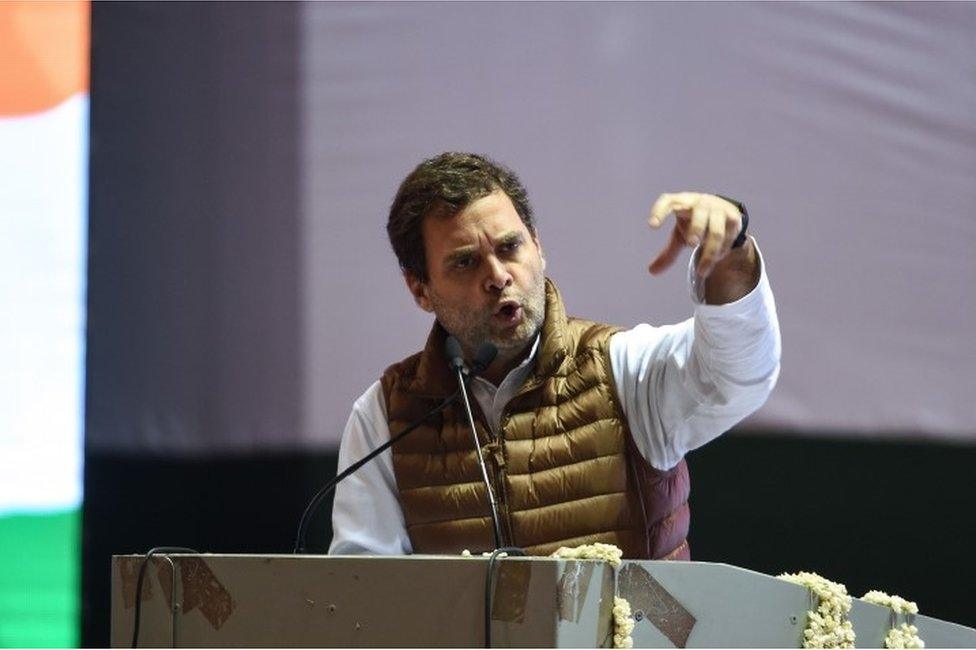
Rahul Gandhi has transformed himself into a more decisive and energetic leader
The number of voters is bigger than the population of Europe and Australia combined.
Indians are enthusiastic voters - the turnout in the last general election in 2014 was more than 66%, up from 45% in 1951 when the first election was held.
More than 8,250 candidates representing 464 parties contested the 2014 elections, nearly a seven-fold increase from the first election.
2. It takes a long, long time
The dates on which voting will be held are 11 April, 18 April, 23 April, 29 April, 6 May, 12 May and 19 May.
Some states will hold polls in several phases.
India's historic first election in 1951-52 took three months to complete. Between 1962 and 1989, elections were completed in four to 10 days. The four-day elections in 1980 were the country's shortest ever.

Read more from Soutik Biswas

Elections in India are long-drawn-out affairs because of the need to secure polling stations.
Local police are seen to be partisan, so federal forces have to deployed. The forces have to be freed from their duties and moved all around the country.
3. It costs a lot of money
India's Centre for Media Studies estimated parties and candidates spent some $5bn (£3.8bn) for the 2014 elections. "It is not inconceivable that overall expenditure will double this year," says Milan Vaishnav, a senior fellow and director of the South Asia Program at the US-based think-tank Carnegie Endowment for International Peace.

Analysts believe the summer elections will largely be a referendum on Mr Modi
Compare it to the $6.5bn that the US spent on the famously free-spending presidential and congressional elections in 2016, and you realise how costly India's elections are.
Financing of political parties in India continues to be opaque despite the fact that they are forced to declare their incomes.
Last year, Mr Modi's government launched electoral bonds, which allow businesses and individuals to donate to parties without their identities being disclosed.
Donors have given away nearly $150m in these bonds - and the bulk of it, according to reports, has gone to the BJP.
4. Will women hold the key?
Indian women are voting in large numbers. So much so, that more women are likely to vote than men this time around, the first time ever in a general election.
The vote gender gap has already shrunk - in 2014, the turnout of women was 65.3% against 67.1% for men.
In more than two dozen local elections between 2012 and 2018, the turnout of women was higher than men in two-thirds of the states.
Political parties have begun treating women as a constituency and offering them more sops: education loans, free cooking gas cylinders, cycles for girls.
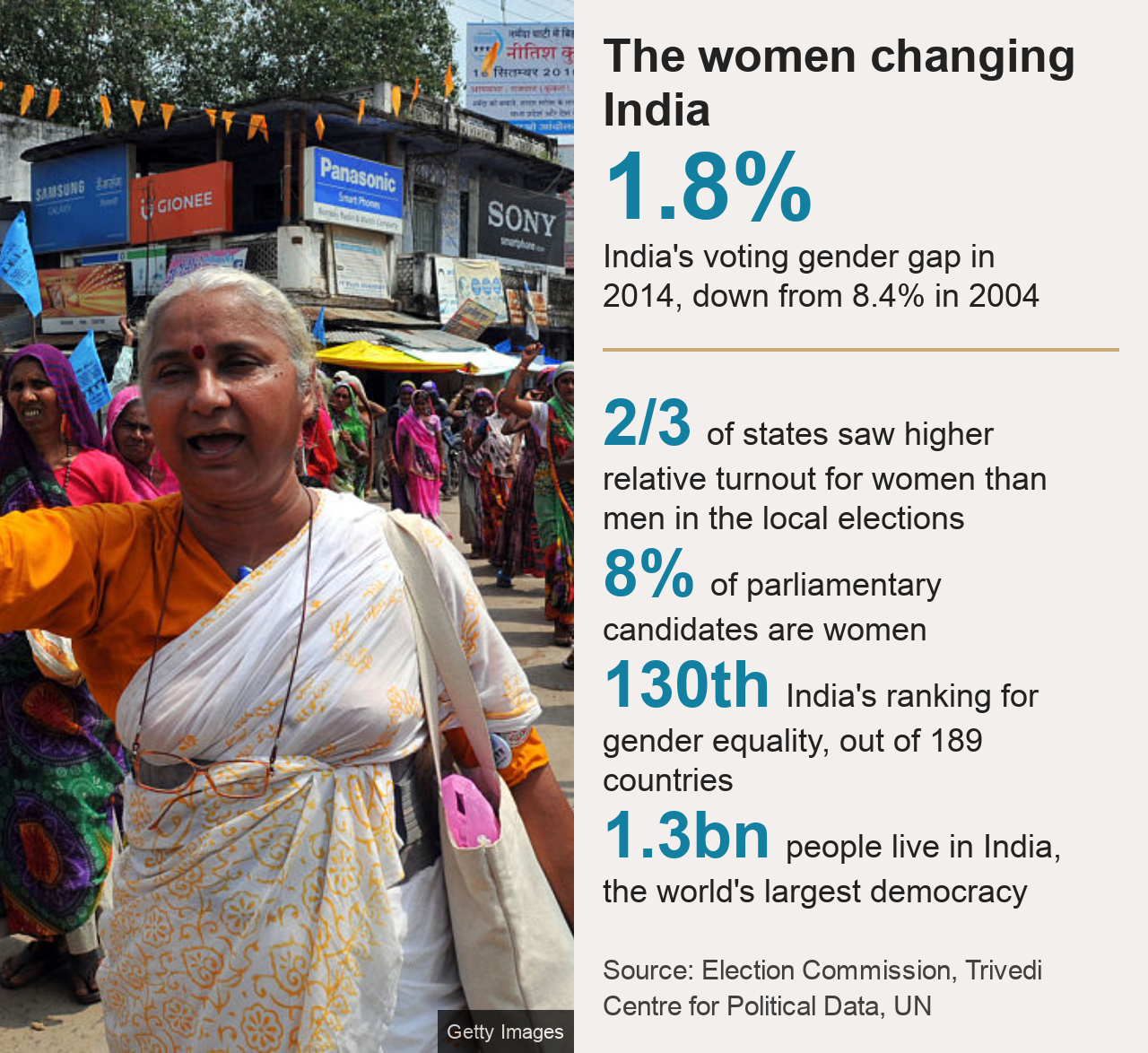
5. It's all about Narendra Modi
In 2014, Mr Modi led his BJP and its allies to a historic victory.
The BJP alone won 282 of the 428 seats it contested. It was the first time since 1984 a party had won an absolute majority in a general election. The BJP also picked up a third of the popular vote.
The staggering win was largely attributed to Mr Modi's ability to promote himself as a decisive, hardworking leader who promised to usher in corruption-free "better times".
Despite a patchy performance on several of his promises, Mr Modi remains his party's main vote-getter. He's also supported by a formidable and disciplined party machinery, run by his trusted and powerful aide Amit Shah.
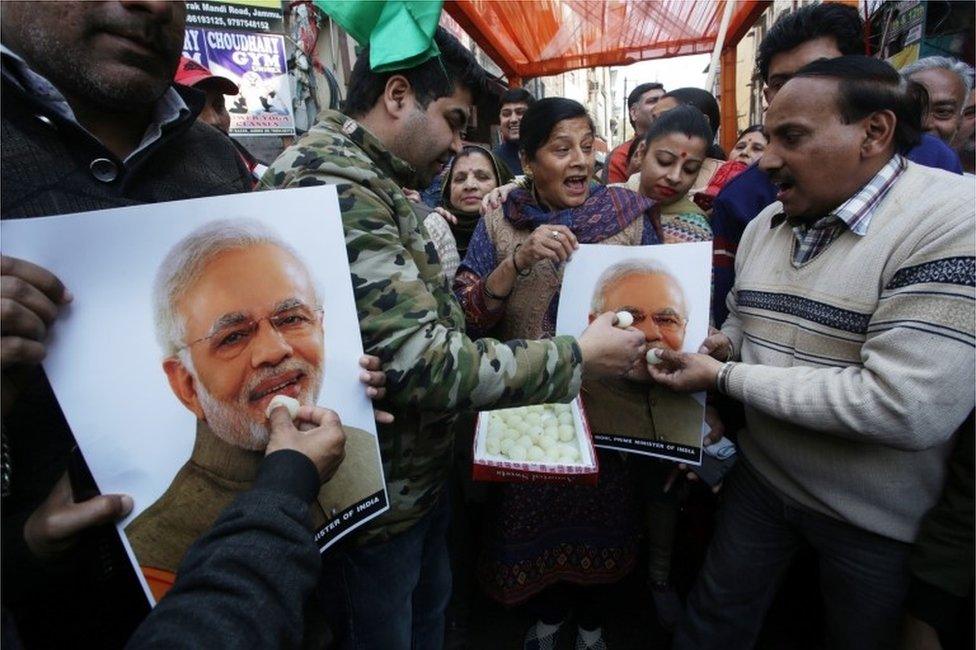
Indians celebrated on hearing news of the strikes on Pakistan
Analysts believe the summer elections will largely be a referendum on Mr Modi.
The opposition campaign will be entirely targeted at the prime minister, a polarising leader who is loved and loathed in equal measure.
So expect a presidential-style faceoff in a parliamentary election. Whether Mr Modi remains a durable brand will be known when the votes are counted.
6. India's Grand Old Party will be hoping for a comeback
Can the 133-year-old Congress party step back from the abyss?
In 2014, the party suffered its worst defeat ever in a general election. It won a mere 44 seats - down from 206 seats - and picked up less than 20% of the popular vote.
Things remained bleak as the party lost a string of state elections over the next four years. By the middle of 2018, the Congress and its allies ran only three state governments, while BJP and its partners ran as many as 20.
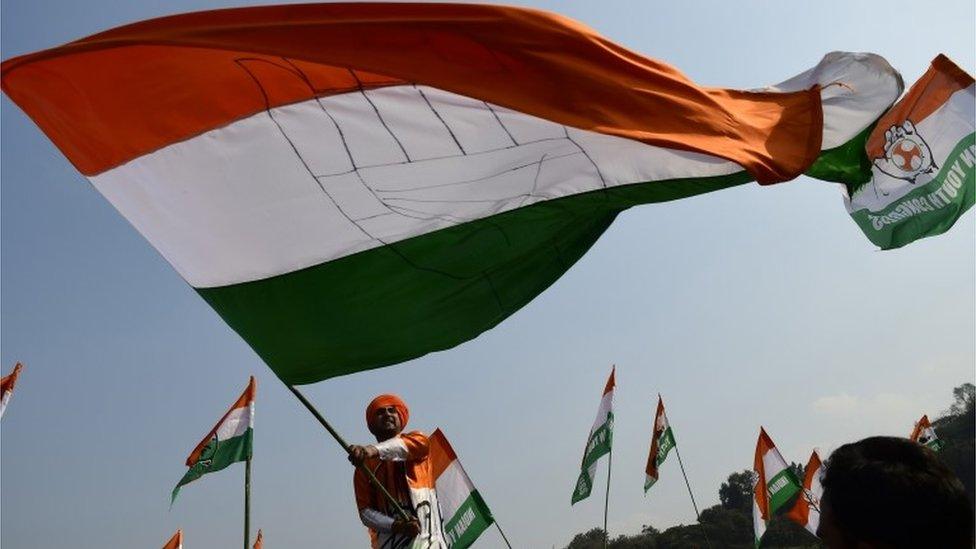
The Congress is looking to stage a comeback
The party appeared to be in terminal decline. Its leader Rahul Gandhi, fourth generation scion of the famous Nehru-Gandhi family, became the butt of social media jokes.
But in December, the party seemed to seemed to have staged a revival of sorts.
Led by a more assured and energetic Mr Gandhi, the Congress wrested three key northern states from the BJP. Many attributed the recovery to anti-incumbency - two of the three states had been ruled by the BJP for years. But it would be churlish to deny Mr Gandhi and his party workers credit.
Clearly, Congress has got some of its old mojo back. Mr Gandhi has positioned himself as a more open and receptive leader in contrast to the forceful and take-no-prisoners leadership style of Mr Modi. And in a surprise move, his charismatic sister Priyanka has been formally inducted into politics to infuse some fresh energy into the party's campaign.Congress's revival has helped rejuvenate a fractured opposition, and promises to make the 2019 election more of a contest than what was believed it would be.
7. It's the economy, stupid
Under Mr Modi, Asia's third-largest economy appears to have lost some of its momentum.
Farm incomes have stagnated because of a crop glut and declining commodity prices, leaving farmers saddled with debt and angry.
The controversial 2016 currency ban - locally called 'demonetisation' - and a complex and badly executed new uniform goods and services tax hurt small and medium businesses and threw many out of their jobs in India's huge informal economy.
Exports have dropped. Joblessness has risen, and Mr Modi's government has been accused of hiding uncomfortable jobs data. To make matters worse, some of India's state-owned banks are drowning in bad loans.
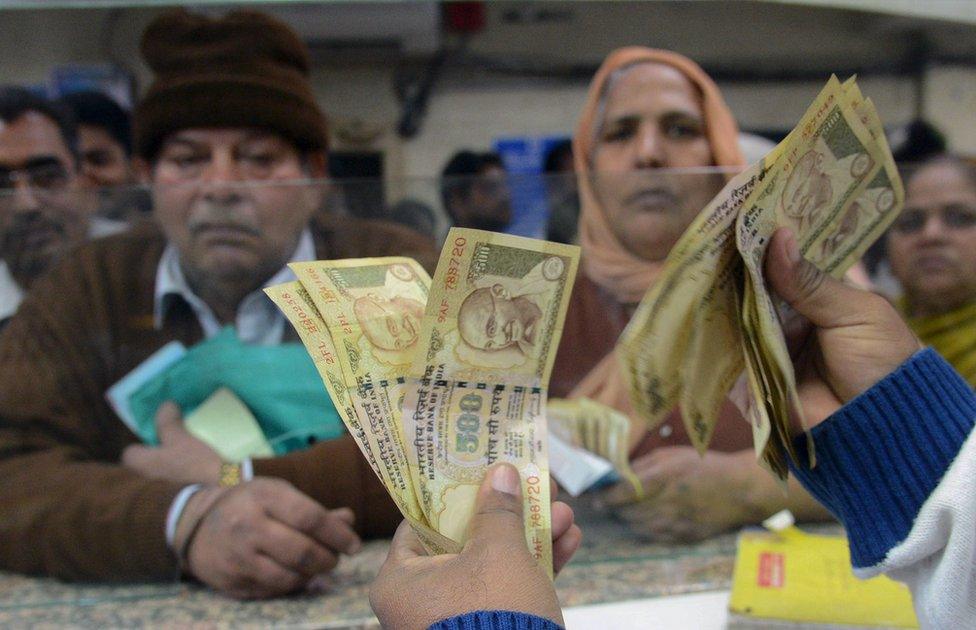
PM Modi cancelled 86% of currency overnight during the 2016 'demonetisation'
Yet, inflation is in check. Increased government spending in infrastructure and public works has kept the economy moving. Growth is expected to be 6.8% this fiscal year.
But the fact is that India's GDP needs to grow at a rate faster than 7% for the country to continue to pull millions out of poverty.
Mr Modi has said reforming the economy is a work in progress. The elections will prove whether people are willing to give him more time.
8. Parties are banking on populism
Economist Rathin Roy says India is moving from a "development state to a compensatory state" where governments are putting cash in the pockets of the poor to cover up for the deficiencies of the state.
The result is competitive populism.
Mr Modi's government has announced direct cash transfers to farmers and waivers of farm loans. It has also promised job quotas for the less well-to-do among the upper castes and other religions.
Rahul Gandhi has promised to guarantee a minimum income for the poor if his party wins the elections. Others will be showering the voters with freebies ranging from TV sets to laptops. There is no clear evidence to show that sops win votes.
9. But nationalism could tilt the balance
Mr Modi's muscular nationalism and his party's majoritarian politics have left India a deeply divided and anxious nation, say critics.
But his supporters say it has energised and consolidated his base. They believe there's no need to be apologetic about political Hinduism because India, well, is an overwhelmingly Hindu nation.
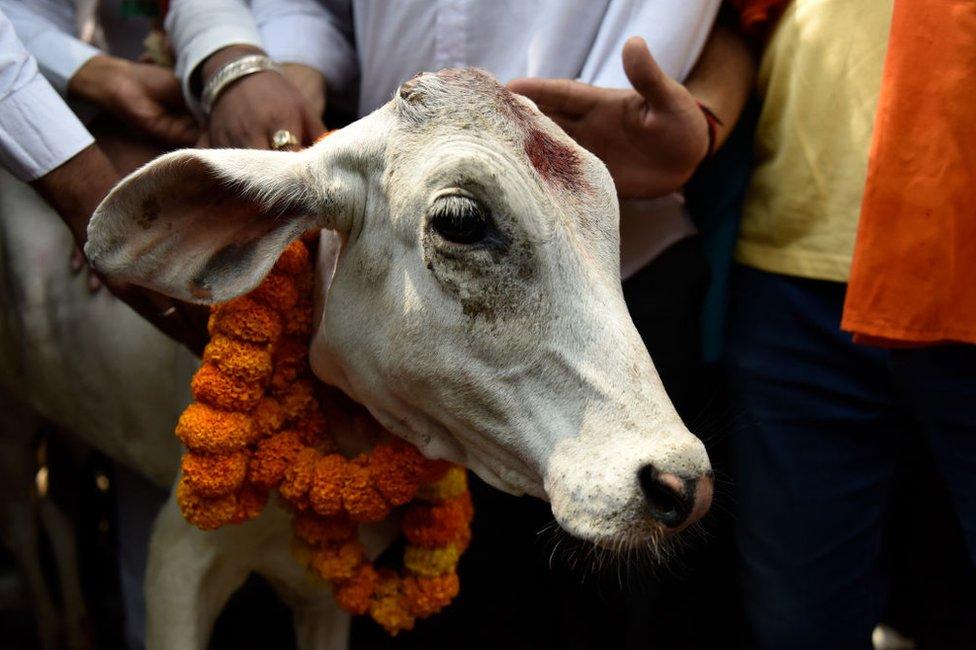
The cow has become a polarising animal
Unfortunately the nationalist rhetoric has emboldened radical rightwing groups to lynch Muslims suspected of smuggling cows. Hindus consider the cow sacred. Thanks to aggressive enforcement of anti-slaughter laws, the cow has become a polarising animal.
People critical of radical Hinduism have been labelled anti-nationals. Dissent is frowned upon.
India's 170 million Muslims, many say, have become the "invisible" minority. The BJP has no Muslim MPs in the lower house - it fielded seven candidates in 2014 and all of them lost.
10. And India's attack on Pakistan could bolster Modi's strongman image
The tit-for-tat aerial bombings by India and Pakistan at the end of February following a deadly suicide attack in Indian-administered Kashmir triggered more nationalistic chest thumping.
Mr Modi has made it clear he would not hesitate to retaliate if there was another attack on Indian soil provoked or sponsored by Pakistan-based militant groups.
What is clear now is that Mr Modi will make national security a key plank of his campaign. Whether this will work is not clear. The opposition has to still come up with a persuasive counter-narrative. Will the pull of nationalism override other issues and fetch swing votes for Mr Modi?
11. A battleground bellwether could decide the polls
The northern state of Uttar Pradesh has an outsize influence on Indian politics.
One in six Indians lives here and it sends 80 MPs to parliament. It is also one of India's most socially divided states.
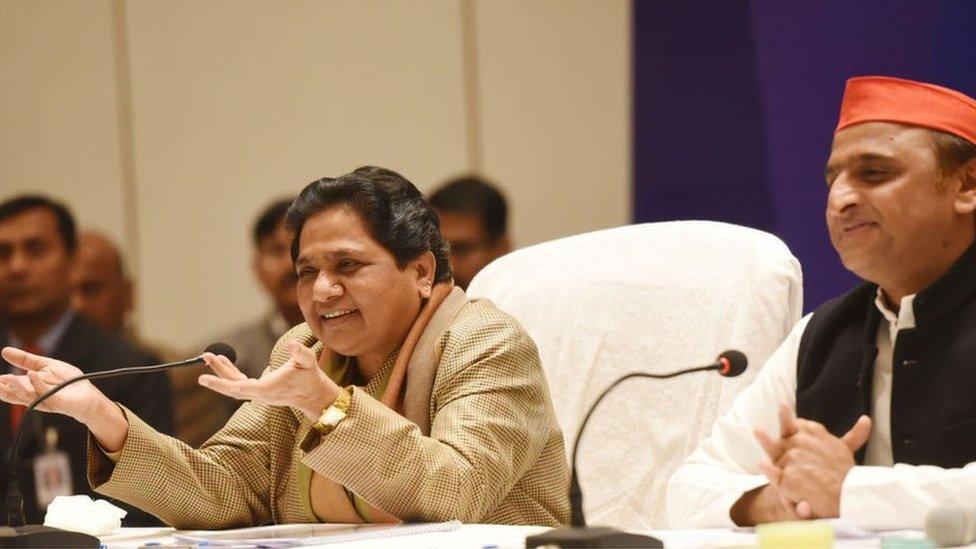
Former rivals Mayawati and Akhilesh Yadav have joined hands to defeat the BJP
The BJP won 71 of the state's 80 seats in 2014. Last time, Mr Modi's charisma and his party's ability to stitch together a rainbow coalition of castes contributed to the rout of powerful regional parties, Samajwadi Party (SP) and Bahujan Samaj Party (BSP).
Ms Mayawati, who heads the BSP, is an icon to millions of low-caste Dalits, a fifth of the state. She has now joined hands with her arch rival Akhilesh Yadav of SP, a nominally socialist party. Together they hope to win more than 50 seats and halt the BJP's march to Delhi.
It is an opportunistic alliance - bitter foes turned strange bedfellows - but could end up hurting the BJP's prospects in the state. It will be pinning its hopes on Mr Modi to neutralise the alliance.
Follow Soutik at @soutikBBC, external
- Published6 March 2019
- Published25 January 2019
- Published12 December 2018